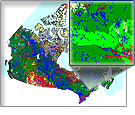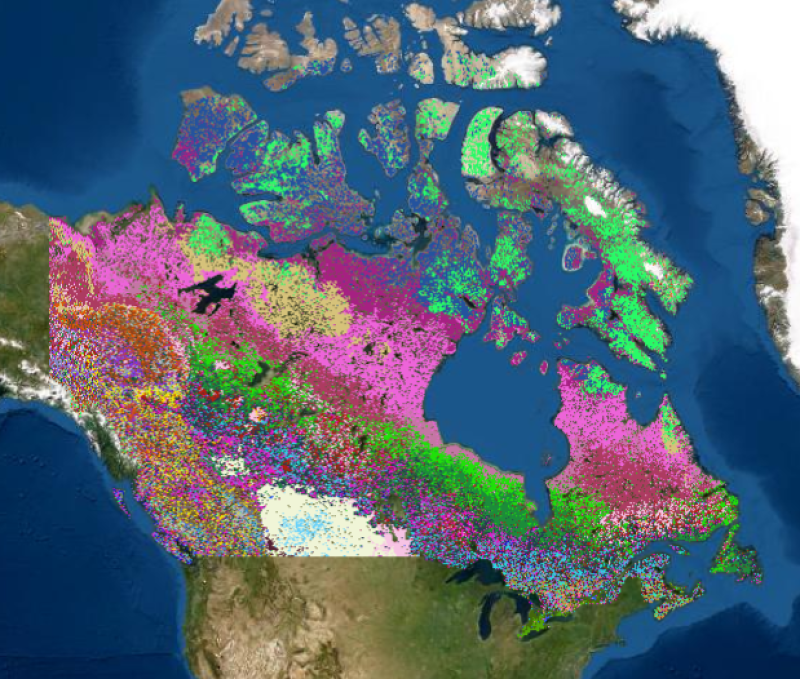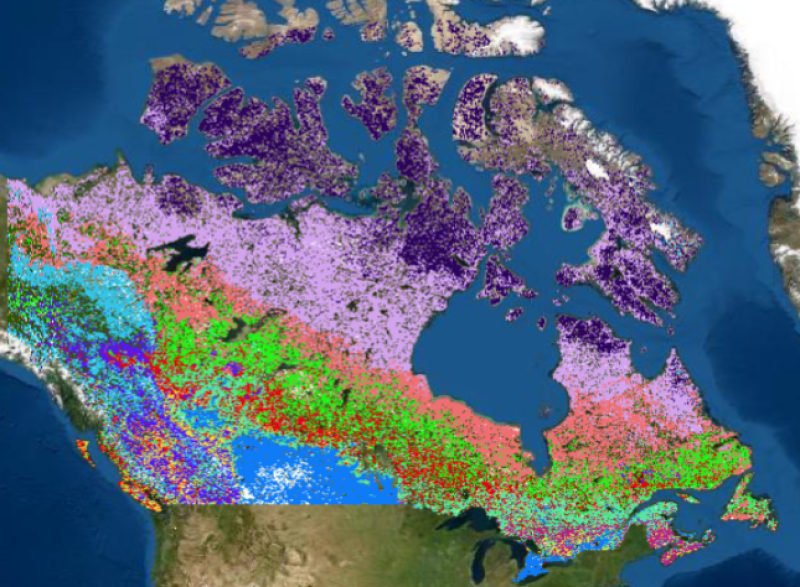Geoscientific information
Type of resources
Available actions
Topics
Keywords
Contact for the resource
Provided by
Years
Formats
Representation types
Update frequencies
status
Scale
Resolution
-

The compilation represents publicly available reports of geochronological information for Canada. This includes federal, provincial and territorial government publications and reports, university theses, books and journals. Current coverage is limited to those areas that have been the target of recent past compilation efforts, with other areas and updates being included as they become ready. Users should be aware that the compilation may not include all available data for a given area. Every effort is made to report the ages without reinterpreting the original authors' intent. However, care has also been taken to highlight the salient features of the data by which the end-user can make initial judgment on the data robustness. Users are cautioned that because of space limitations and the necessary summarization of often complex datasets, that the original publication should be consulted to verify age interpretations and their rationale. Data may be extracted by the user in tab-delimited text format.
-

The Yukon Detailed Soil Survey dataset series consists of geo-referenced soil polygons with linkages to attribute data found in the associated Component File (CMP), Soil Names File (SNF) and Soil Layer File (SLF). Together, these datasets describe the spatial distribution of soils and associated landforms in the major valleys of the Yukon.
-

Forest 95th Percentile Elevation(Ht) 2015 95th percentile of first returns height (m). Products relating the structure of Canada's forested ecosystems have been generated and made openly accessible. The shared products are based upon peer-reviewed science and relate aspects of forest structure including: (i) metrics calculated directly from the lidar point cloud with heights normalized to heights above the ground surface (e.g., canopy cover, height), and (ii) modelled inventory attributes, derived using an area-based approach generated by using co-located ground plot and ALS data (e.g., volume, biomass). Forest structure estimates were generated by combining information from lidar plots (Wulder et al. 2012) with Landsat pixel-based composites (White et al. 2014; Hermosilla et al. 2016) using a nearest neighbour imputation approach with a Random Forests-based distance metric. These products were generated for strategic-level forest monitoring information needs and are not intended to support operational-level forest management. All products have a spatial resolution of 30 m. For a detailed description of the data, methods applied, and accuracy assessment results see Matasci et al. (2018). When using this data, please cite as follows: Matasci, G., Hermosilla, T., Wulder, M.A., White, J.C., Coops, N.C., Hobart, G.W., Bolton, D.K., Tompalski, P., Bater, C.W., 2018b. Three decades of forest structural dynamics over Canada's forested ecosystems using Landsat time-series and lidar plots. Remote Sensing of Environment 216, 697-714. Matasci et al. 2018) Geographic extent: Canada's forested ecosystems (~ 650 Mha) Time period: 1985–2011
-

40 Class - Canadian Ecological Domain Classification from Satellite Data. Satellite derived data including 1) topography, 2) landscape productivity based on photosynthetic activity, and 3) land cover were used as inputs to create an environmental regionalization of the over 10 million km2 of Canada’s terrestrial land base. The outcomes of this clustering consists of three main outputs. An initial clustering of 100 classes was generated using a two-stage multivariate classification process. Next, an agglomerative hierarchy using a log-likelihood distance measure was applied to create a 40 and then a 14 class regionalization, aimed to meaningfully group ecologically similar components of Canada's terrestrial landscape. For more information (including a graphical illustration of the cluster hierarchy) and to cite this data please use: Coops, N.C., Wulder, M.A., Iwanicka, D. 2009. An environmental domain classification of Canada using earth observation data for biodiversity assessment. Ecological Informatics, Vol. 4, No. 1, Pp. 8-22, DOI: https://doi.org/10.1016/j.ecoinf.2008.09.005. ( Coops et al. 2009).
-

High-resolution binary wetland map for Canada (2001-2016). Wetland map for the forested ecosystems of Canada focused on current conditions. The binary wetland data included in this product is national in scope (entirety of forested ecosystem) and represents the wall to wall characterization for 2001-2016 (see Wulder et al. 2018). This product was generated using both annual gap free composite reflectance images and annual forest change maps following the Virtual Land Cover Engine (VLCE) process (see Hermosilla et al. 2018), over the 650 million ha forested ecosystems of Canada. Elements of the VLCE classification approach are inclusion of disturbance information in the processes as well as ensuring class transitions over time are logical. Further, a Hidden Markov Model is implemented to assess individual year class likelihoods to reduce variability and possible noise in year-on-year class assignments (for instances when class likelihoods are similar). For this product, to be considered as currently a wetland a pixel must have been classified as wetland at least 80% or 13 of the 16 years between 2001 and 2016, inclusively. For an overview on the data, image processing, and time series change detection methods applied, see Wulder et al. (2018). Wulder, M.A., Z. Li, E. Campbell, J.C. White, G. Hobart, T. Hermosilla, and N.C. Coops (2018). A National Assessment of Wetland Status and Trends for Canada’s Forested Ecosystems Using 33 Years of Earth Observation Satellite Data. Remote Sensing. For a detailed description of the VLCE process and the subsequently generated land cover product, including an accuracy assessment, please see Hermosilla et al. (2018).
-

The wetland year count data included in this product is national in scope (entire forested ecosystem) and represents a wall to wall wetland characterization for 1984-2016 (Wulder et al. 2018). This product was generated using both annual gap free composite reflectance images and annual forest change maps following the Virtual Land Cover Engine (VLCE) process (see Hermosilla et al. 2018), over the 650 million ha forested ecosystems of Canada. Elements of the VLCE classification approach are inclusion of disturbance information in the processes as well as ensuring class transitions over time are logical. Further, a Hidden Markov Model is implemented to assess individual year class likelihoods to reduce variability and possible noise in year-on-year class assignments (for instances when class likelihoods are similar). The values can range from 0 to 33 denoting the number of years between 1984 and 2016 that a pixel was classified as wetland or wetland-treed in the VLCE data cube. For an overview on the data, image processing, and time series change detection methods applied, as well as information on independent accuracy assessment of the data, see Hermosilla et al. (2016; http://www.tandfonline.com/doi/full/10.1080/17538947.2016.1187673). A detailed description of the VLCE process and the subsequently generated land cover product, including an accuracy assessment, please see Hermosilla et al. (2018). The focused wetland analyses can be found described in Wulder et al (2018). Geographic extent: Canada's forested ecosystems (~ 650 Mha) Time period: 1985–2011
-

14 Class - Canadian Ecological Domain Classification from Satellite Data. Satellite derived data including 1) topography, 2) landscape productivity based on photosynthetic activity, and 3) land cover were used as inputs to create an environmental regionalization of the over 10 million km2 of Canada’s terrestrial land base. The outcomes of this clustering consists of three main outputs. An initial clustering of 100 classes was generated using a two-stage multivariate classification process. Next, an agglomerative hierarchy using a log-likelihood distance measure was applied to create a 40 and then a 14 class regionalization, aimed to meaningfully group ecologically similar components of Canada's terrestrial landscape. For more information (including a graphical illustration of the cluster hierarchy) and to cite this data please use: Coops, N.C., Wulder, M.A., Iwanicka, D. 2009. An environmental domain classification of Canada using earth observation data for biodiversity assessment. Ecological Informatics, Vol. 4, No. 1, Pp. 8-22, DOI: https://doi.org/10.1016/j.ecoinf.2008.09.005. ( Coops et al. 2009).
-

The Saskatchewan Detailed Soil Survey dataset series at a scale of 1:100 000 consists of geo-referenced soil polygons with linkages to attribute data found in the associated Component File (CMP), Soil Names File (SNF) and Soil Layer File (SLF). Together, these datasets describe the spatial distribution of soils and associated landscapes for nearly all agricultural areas in southern Saskatchewan.
-

Forest Elevation(Ht) Stddev 2015 Standard deviation of height of lidar first returns (m). Represents the variability in canopy heights. Products relating the structure of Canada's forested ecosystems have been generated and made openly accessible. The shared products are based upon peer-reviewed science and relate aspects of forest structure including: (i) metrics calculated directly from the lidar point cloud with heights normalized to heights above the ground surface (e.g., canopy cover, height), and (ii) modelled inventory attributes, derived using an area-based approach generated by using co-located ground plot and ALS data (e.g., volume, biomass). Forest structure estimates were generated by combining information from lidar plots (Wulder et al. 2012) with Landsat pixel-based composites (White et al. 2014; Hermosilla et al. 2016) using a nearest neighbour imputation approach with a Random Forests-based distance metric. These products were generated for strategic-level forest monitoring information needs and are not intended to support operational-level forest management. All products have a spatial resolution of 30 m. For a detailed description of the data, methods applied, and accuracy assessment results see Matasci et al. (2018). When using this data, please cite as follows: Matasci, G., Hermosilla, T., Wulder, M.A., White, J.C., Coops, N.C., Hobart, G.W., Bolton, D.K., Tompalski, P., Bater, C.W., 2018b. Three decades of forest structural dynamics over Canada's forested ecosystems using Landsat time-series and lidar plots. Remote Sensing of Environment 216, 697-714. Matasci et al. 2018) Geographic extent: Canada's forested ecosystems (~ 650 Mha) Time period: 1985–2011
-

Forest Gross Stem Volume 2015 Gross stem volume. Individual tree gross volumes are calculated using species-specific allometric equations. In the measured ground plots, gross total volume per hectare is calculated by summing the gross total volume of all trees and dividing by the area of the plot (units = m3ha-1). Products relating the structure of Canada's forested ecosystems have been generated and made openly accessible. The shared products are based upon peer-reviewed science and relate aspects of forest structure including: (i) metrics calculated directly from the lidar point cloud with heights normalized to heights above the ground surface (e.g., canopy cover, height), and (ii) modelled inventory attributes, derived using an area-based approach generated by using co-located ground plot and ALS data (e.g., volume, biomass). Forest structure estimates were generated by combining information from lidar plots (Wulder et al. 2012) with Landsat pixel-based composites (White et al. 2014; Hermosilla et al. 2016) using a nearest neighbour imputation approach with a Random Forests-based distance metric. These products were generated for strategic-level forest monitoring information needs and are not intended to support operational-level forest management. All products have a spatial resolution of 30 m. For a detailed description of the data, methods applied, and accuracy assessment results see Matasci et al. (2018). When using this data, please cite as follows: Matasci, G., Hermosilla, T., Wulder, M.A., White, J.C., Coops, N.C., Hobart, G.W., Bolton, D.K., Tompalski, P., Bater, C.W., 2018b. Three decades of forest structural dynamics over Canada's forested ecosystems using Landsat time-series and lidar plots. Remote Sensing of Environment 216, 697-714. Matasci et al. 2018) Geographic extent: Canada's forested ecosystems (~ 650 Mha) Time period: 1985–2011
 Arctic SDI catalogue
Arctic SDI catalogue